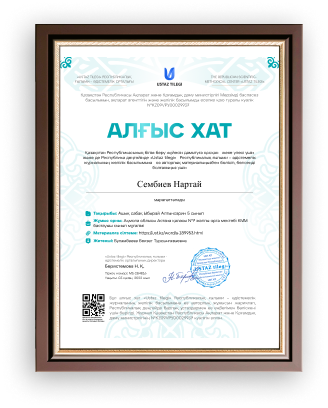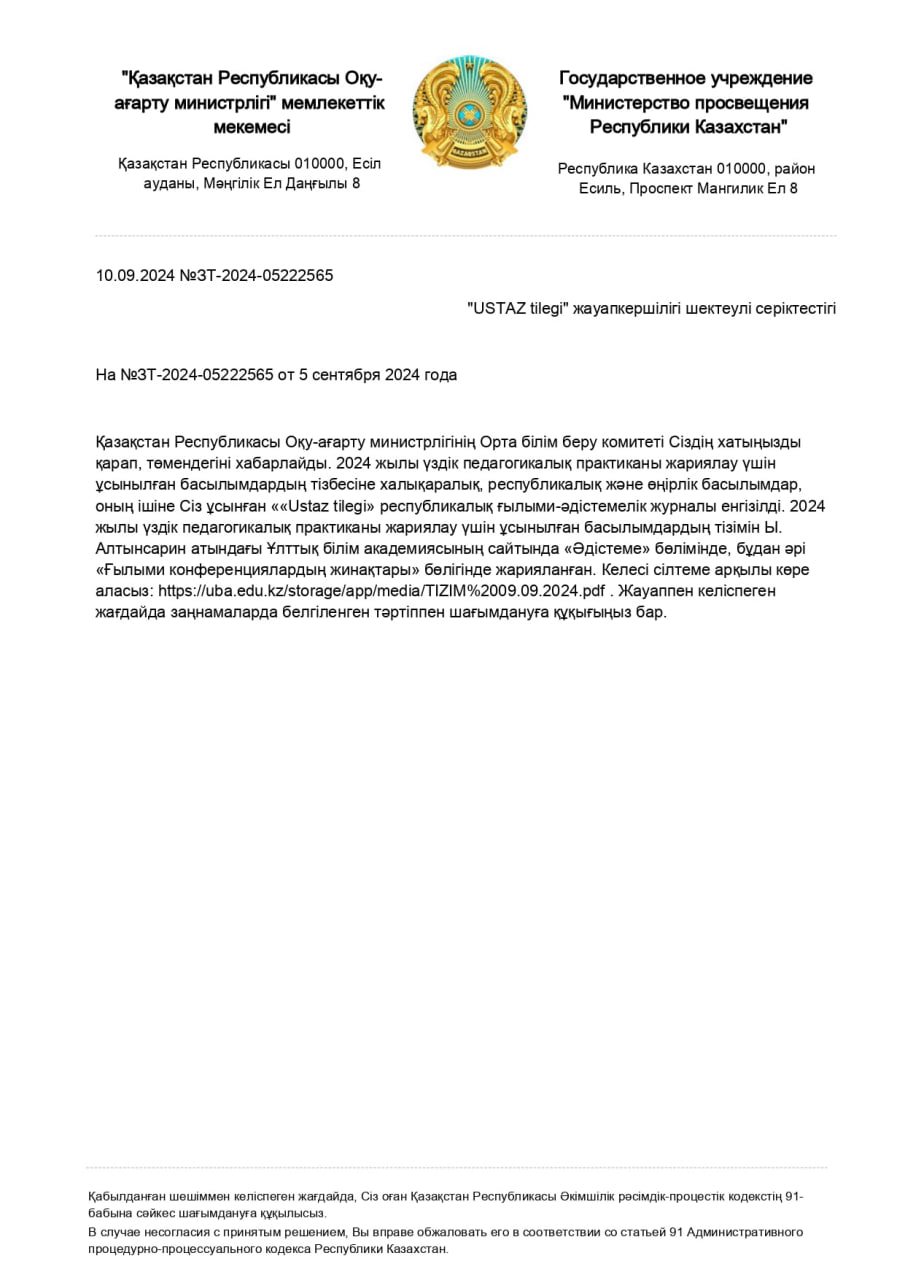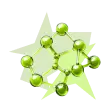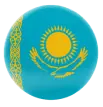Бұл материал сайт қолданушысы жариялаған. Материалдың ішінде жазылған барлық ақпаратқа жауапкершілікті жариялаған қолданушы жауап береді. Ұстаз тілегі тек ақпаратты таратуға қолдау көрсетеді. Егер материал сіздің авторлық құқығыңызды бұзған болса немесе басқа да себептермен сайттан өшіру керек деп ойласаңыз осында жазыңыз

Бонусты жинап картаңызға (kaspi Gold, Halyk bank) шығарып аласыз
1 жыл бойы тегін жүктеу мүмкіндігіне ие болыңыз!

жеңілдік
11 ЕМН summative assessment for term 3

SPECIFICATION OF THE SUMMATIVE ASSESSMENT FOR TERM 3
Review of the summative assessment for term 3 Duration of summative assessment – 45 minutes
Listening – 10 minutes
Reading – 10 minutes Writing – 25 minutes
Speaking task is conducted separately.
Total marks - 24
The structure of summative assessment
This sample of Summative Assessment consists of 14 tasks: listening, reading, writing and speaking. Different types of tasks are used in the Summative Assessment for term.
Listening – tasks to test learners’ effective listening on the topic “Work and inventions”. Transcript for listening task can be found after the mark scheme.
Reading – tasks to test learners’ effective reading on the topic “STEM”.
Writing – open-ended questions on the topics “Work and inventions” and/or topic “STEM”.
Speaking – a pair speaking on the topics “Work and inventions” and/or topic “STEM
42
Characteristic of tasks for the summative assessment for term 3
|
Unit |
Strand |
Learning objective |
*Total number of questions |
*Question № |
*Type of task |
*Task description |
Time |
Total marks |
|
Work and inventions STEM |
Listening |
11.2.7 Understand speaker viewpoints and extent of explicit agreement between speakers on a range of general and curricular topics, including some unfamiliar topics |
6 |
1 2 3 4 5 6 |
Multiple choice |
These questions with the suggested options to choose can be used to check the learners’ skills of being effective at testing listening to understand speaker viewpoints. While doing this task, the learners’ spelling, vocabulary, and ability of paraphrasing can be checked. Learners listen to the recording on the topic “Work and inventions” and complete the summary with no more than one word. Learners should listen to the recording twice, having a chance to look through the questions before the recording starts. Learners should have a minute extra after the first and the second times to write down the answers and check them. |
10 minutes |
6 |
|
|
Reading |
11.4.2 Understand specific information and detail in extended texts on a wide range of familiar and unfamiliar general and curricular topics |
6 |
1 2 3 4 5 6 |
Yes / No / Not given |
These Yes/ No/ Not given questions can be used to check the learners’ skills of being effective at testing reading to understand complex and abstract main points in unsupported extended talk While doing this task, the learners’ spelling, vocabulary, and ability of paraphrasing can be checked. Learners read the article on the topic “STEM” and identify the specific and detailed information by completing the tasks. |
10 minutes |
6 |
|
Writing |
11.5.5 Develop with minimal support coherent arguments supported when necessary by examples and reasons for a wide range of written genres in familiar general and curricular topics |
1 |
1 |
Open- ended questions |
Learners choose to write one type of the suggested writings on the topic “Work and inventions” and/or topic “STEM”. Learners should support their arguments by providing examples and evidence. The suggested volume is 150-200 words. |
25 minutes |
6 |
|
|
Speaking |
11.3.5 Interact with peers to make hypotheses and evaluate alternative proposals on a range of familiar and some |
1 |
1 |
Pair speaking |
Learners discuss the suggested questions in pairs on the topics “Work and inventions” and/or topic “STEM” by providing possible solutions or proposals |
1 minute for preparation 3-4 minutes for speaking |
6 |
|
|
|
unfamiliar general and curricular topics |
|
|
|
on the given issues Learners should cover all the given questions and present a dialogue. |
|
|
|
TOTAL: |
45 minutes (excluding Speaking) |
24 |
||||||
|
Note: * - sections that can be changed |
||||||||
Sample questions and mark scheme Tasks for Summative Assessment for term 3
LISTENING
Task. Listen to the recording and complete the multiple choice tasks (stop at 3:06). Choose the option which reflects the viewpoint of Jed, a science correspondent. There is only one correct option in each question.
-
How does Jed feel about the development of modern wingsuits? [1]
-
He believes they are overrated and not worth the price.
-
He is excited about their potential and considers them the ultimate in cool.
-
He thinks they are too expensive for most people.
-
He is concerned about their impact on the environment.
-
-
What is Jed's opinion about the solar water distiller created by Gabriele Diamanti? [1]
-
He is impressed by its simplicity and affordability.
-
He doesn't see the need for such a device.
-
He doubts its effectiveness in providing clean water.
-
He believes it requires significant investment to be useful.
-
-
How does Jed view the 'enable talk gloves' invented by Ukrainian students? [1]
-
He is doubtful about their practicality and benefits.
-
He sees them as a revolutionary invention.
-
He thinks they are too complicated to be useful.
-
He believes they will be expensive to produce.
-
-
What is Jed's opinion about James Cameron's dive in the Deepsea Challenger Submarine?
-
He thinks it was a waste of resources. [1]
-
He considers it an impressive and important feat.
-
He doesn't have any particular viewpoint on it.
-
He believes it was overshadowed by other events.
-
-
According to Jed, why is it important to explore the deepest parts of the ocean? [1]
-
To break speed records for deep-sea dives.
-
To uncover hidden treasures from shipwrecks.
-
To advance the field of engineering.
-
To expand our knowledge of the sea's depths.
-
-
How does Jed feel about the common problem of getting tomato ketchup out of a bottle?
-
He finds it amusing and not worth discussing. [1]
-
He agrees with the presenter that it's annoying.
-
He considers it a problem with a simple solution.
-
He believes it's a significant issue that needs attention.
-
Total [6]
READING
Task. Read the text and complete the task below.
Research and development
The interrelationship of science, technology, and industry is taken for granted today – summed up, not altogether accurately, as “research and development.” Yet historically this widespread faith in the economic virtues of science is a relatively recent phenomenon, dating back in the United States about 150 years, and in the Western world as a whole not over 300 years at most. Even in this current era of large scale, intensive research and development, the interrelationships involved in this process are frequently misunderstood. Until the coming of the Industrial Revolution, science and technology evolved for the most part independently of each other. Then as industrialization became increasingly complicated, the craft techniques of preindustrial society gradually gave way to a technology based on the systematic application of scientific knowledge and scientific methods. This changeover started slowly and progressed unevenly. Until late in the nineteenth century, only a few industries could use scientific techniques or cared about using them. The list expanded noticeably after 1870, but even then much of what passed for the application of science was “engineering science” rather than basic science.
Nevertheless, by the middle of the nineteenth century, the rapid expansion of scientific knowledge and of public awareness-if not understanding-of it had created a belief that the advance of science would in some unspecified manner automatically generate economic benefits. The widespread and usually uncritical acceptance of this thesis led in turn to the assumption that the application of science to industrial purposes was a linear process, starting with fundamental science, then proceeding to applied science or technology, and through them to industrial use. This is probably the most common pattern, but it is not invariable. New areas of science have been opened up and fundamental discoveries made as a result of attempts to solve a specific technical or economic problem. Conversely, scientists who mainly do basic research also serve as consultants on projects that apply research in practical ways.
In sum, the science-technology-industry relationship may flow in several different ways, and the particular channel it will follow depends on the individual situation. It may at times even be multidirectional
Identify whether the statements below are Yes/ No/ Not given.
-
The interrelationship of science, technology, and industry is referred to as "research and development" today. [1]
-
Science and technology developed separately from one another until the onset of the Industrial Revolution. [1]
-
During the mid-nineteenth century, it was commonly believed that the progress of science would naturally lead to economic advantages. [1]
-
The application of science to industrial purposes always follows a linear process starting with fundamental science. [1]
-
Scientists who mainly do basic research do not serve as consultants on projects that apply research in practical ways. [1]
-
The direction of the science-technology-industry relationship always follows a single, fixed pattern. [1]
Total [6]
WRITING
Choose one topic to write an article
Task. Imagine that you are an engineer and invented a new device. Write an article for the Innovative Journal to present and advertise your invention. Develop sustainable arguments about the benefits of your device and how it can contribute to the development of humanity. Follow the article structure and style. Write in 150-200 words.















